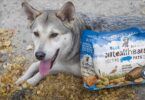Nearly 34% of pet owners admit sharing human desserts with their furry companions, often unaware of hidden risks. This statistic highlights a common dilemma: balancing nostalgic treats like jello with pet safety. While gelatin-based snacks evoke childhood memories, their suitability for four-legged family members requires careful thought.
Jello’s vibrant colors and sweet taste make it appealing, but its ingredients raise concerns. The dessert often contains high sugar levels, artificial flavors, and additives like xylitol—substances that may harm canine health. Even small quantities could trigger digestive issues or long-term complications.
Pure gelatin offers benefits like joint support, but commercial varieties rarely provide these advantages. Instead, they prioritize taste over nutritional value. Pet owners must scrutinize labels for harmful components before offering any human food.
This article explores the risks of feeding gelatin-based desserts to pets, examines potential benefits, and suggests safer alternatives. Understanding ingredient lists and recognizing warning signs ensures informed decisions for your companion’s well-being.
Understanding Jello and Its Ingredients
What gives this wobbly dessert its signature bounce? The answer lies in gelatin, a protein extracted from animal collagen through boiling bones and connective tissues. This processed ingredient forms jello’s structure when mixed with water and chilled. Commercial varieties amplify sweetness and visual appeal with added sugars, artificial dyes, and flavor enhancers.
Gelatin: The Main Component
Gelatin powder acts as jello’s foundation. Derived primarily from pigs or cows, it transforms liquid into a semi-solid state. Unflavored gelatin lacks additives but rarely appears in store-bought desserts. Most products use flavored versions packed with extra ingredients.
Sugar, Artificial Flavors, and Colors
A single serving of jello often contains over 15 grams of sugar. Artificial sweeteners like xylitol replace sugar in “sugar-free” options, creating toxicity risks. Bright hues come from synthetic dyes linked to hyperactivity in studies. These additives enhance taste and appearance but offer zero nutritional value.
Jello products vary widely—powdered mixes require preparation, while pre-made cups skip cooking steps. Both forms prioritize human preferences over pet safety. Reading labels helps identify hidden threats in this popular food.
Uncovering the Risks of Jello for Dogs
Behind jello’s appealing appearance lie ingredients that can harm canine health. While humans enjoy its sweet texture, common additives create significant threats for pets. Even small portions may trigger reactions requiring veterinary care.
Digestive and Gastrointestinal Concerns
High sugar content disrupts digestive balance. Consuming sugary snacks often leads to diarrhea, stomach cramps, or vomiting within hours. These symptoms worsen in pets with sensitive systems or existing gastrointestinal problems.
Artificial colors and preservatives further irritate the stomach lining. Repeated exposure may cause chronic inflammation. Owners should monitor for lethargy or appetite changes after accidental ingestion.
Potential Toxicity from Additives
Xylitol ranks among the most dangerous artificial sweeteners. This sugar substitute triggers rapid insulin release, causing hypoglycemia. Signs include weakness, tremors, and seizures.
Some brands use sweeteners linked to liver failure in extreme cases. Toxic reactions may develop gradually, making early detection challenging. Immediate veterinary attention becomes crucial if exposure occurs.
Always check labels for hidden additives before sharing human foods. Safer treat options exist that prioritize pet wellness over temporary indulgence.
Can Dogs Eat Jello: Analyzing Safety and Health Impacts
Veterinary nutritionists emphasize that occasional exposure to gelatin-based treats rarely causes severe harm. However, frequent consumption creates cumulative risks many owners overlook. Short-term effects often appear within 24 hours, while chronic issues develop silently over months.
Immediate Responses Versus Chronic Conditions
Mild digestive upset manifests as vomiting or diarrhea after initial ingestion. These acute reactions usually resolve within a day if no toxic sweeteners are present. Lethargy may indicate blood sugar spikes from excessive sugars.
Long-term feeding patterns introduce greater dangers. Regular sugar intake contributes to obesity and diabetes in pets. Artificial sweeteners like xylitol—found in sugar-free varieties—can damage liver function over time. Studies show even small weekly doses alter metabolic processes.
Pure gelatin supports joint health, but commercial desserts dilute these benefits with harmful additives. Dr. Angela Hofmann, a veterinary researcher, notes: “The risks of artificial colors and preservatives outweigh any potential advantages for canine diets.”
Pet owners should prioritize specially formulated treats that balance nutrition with safety. Occasional lapses might cause temporary discomfort, but repeated exposure turns minor issues into lifelong health challenges.
The Impact of Sugar and Artificial Sweeteners on Canine Health
Many pet owners underestimate how everyday snacks affect their companions’ well-being. Sugary desserts often contain additives that disrupt metabolic balance, particularly in smaller animals. Understanding these risks helps create safer feeding habits.
Xylitol and Other Harmful Sweeteners
Xylitol ranks among the most dangerous ingredients in sugar-free products. This sweetener triggers rapid insulin spikes, potentially causing seizures or liver failure within hours. Veterinary studies show 90% of toxicity cases involve accidental ingestion of human foods containing such additives.
Other artificial sweeteners like aspartame may cause gastrointestinal distress. While less immediately toxic, they contribute to long-term digestive issues. Always check labels for hidden chemical additives before sharing snacks.
Effects on Blood Sugar and Weight
Regular sugar consumption leads to weight gain in 1 out of 3 pets, according to veterinary nutrition surveys. Excess calories convert to fat stores, increasing obesity risks. This condition elevates joint stress and diabetes susceptibility.
Blood sugar fluctuations from sugary treats strain the pancreas over time. Consistent spikes may lead to insulin resistance—a precursor to diabetes. Opt for low-glycemic alternatives like carrots or safe whipped cream options during treat time.
Moderation remains key. Limit sweet snacks to 10% of daily calories and prioritize vet-approved options. Balanced nutrition supports lasting vitality without metabolic disruptions.
Weighing the Benefits of Gelatin for Dogs
Pure gelatin offers surprising advantages when used correctly in canine diets. Unlike sugary desserts, this natural protein source contains collagen derived from animal bones and connective tissues. When prepared without additives, it becomes a functional supplement supporting physical wellness.
Support for Joint and Connective Tissue Health
Collagen makes up 30% of a dog’s body proteins, forming cartilage and ligaments. Gelatin replenishes this vital compound, easing stiffness in older pets. Studies show improved mobility in arthritic animals after consistent supplementation.
Veterinarians often recommend gelatin for breeds prone to hip dysplasia. One case involved a Labrador retriever showing 40% less limping after six weeks of bone broth-based meals. The amino acids in collagen help repair worn joint tissues naturally.
Improved Digestion and Nutrient Absorption
Gelatin binds water in the digestive tract, creating a protective lining. This reduces inflammation in sensitive stomachs and enhances mineral uptake. Pets with food intolerances often tolerate meals better when gelatin is added.
As a protein-rich additive, it supports muscle maintenance in growing puppies and senior companions. Always choose unflavored gelatin to avoid hidden sweeteners or artificial colors. Mixing a teaspoon into wet food provides benefits without altering taste preferences.
Homemade Gelatin Treats and Safer Alternatives for Your Dog
Pet owners seeking nutritious snacks can craft gelatin-based goodies tailored to their companion’s needs. Using simple recipes and vet-approved ingredients, these homemade options provide texture and flavor without harmful additives.
Simple Homemade Recipes
Start with a basic chicken broth gelatin. Mix 1 packet of unflavored gelatin powder with 2 cups of low-sodium chicken stock. Stir over low heat until dissolved, then pour into silicone molds. Add cooked shredded chicken before refrigerating for 4 hours.
For fruit-infused varieties, blend pureed pumpkin or mashed blueberries into the mixture. These natural additions provide fiber and antioxidants. Freeze portions in ice cube trays for teething puppies or summer refreshment.
Choosing Dog-Friendly Ingredients
Always select plain gelatin powder without added sweeteners like xylitol or artificial colors. Bone broth offers more protein than water while supporting joint health. Avoid sugary fruits like grapes and opt for apple slices or bananas in moderation.
Portion sizes matter: small breeds need teaspoon-sized servings, while larger companions can handle tablespoon amounts. Introduce new foods gradually to monitor digestion. Homemade treats let you control quality while strengthening the bond with your furry friend through shared snack time.
Practical Tips and Veterinarian Guidance for Pet Owners
Responsible pet ownership involves more than just love—it requires informed decisions about every treat. Proactive feeding strategies paired with professional advice create the safest approach to dietary choices. Collaboration with your veterinary team ensures tailored solutions for your companion’s unique needs.
Safe Feeding Practices
Introduce new foods gradually over 3-5 days. Start with pea-sized portions mixed into regular meals. Observe for vomiting, diarrhea, or skin irritations—common signs of adverse reactions.
Always verify ingredient lists for hidden threats like artificial sweeteners or preservatives. Xylitol often appears in “sugar-free” products and can cause blood sugar crashes. Store-bought items may contain onion powder or caffeine derivatives harmful to liver function.
Homemade gelatin treats using plain collagen and chicken broth offer safer alternatives. Avoid adding sugar substitutes or flavor enhancers. Portion control prevents digestive overload while maintaining nutritional balance.
When and Why to Consult Your Vet
Schedule a consultation before changing diets for pets with existing health conditions. Animals with diabetes, kidney issues, or food allergies require specialized meal plans. Vets assess individual risks based on weight, age, and medical history.
Seek immediate care if your companion shows tremors, lethargy, or breathing difficulties after eating. These symptoms could indicate toxin exposure requiring urgent treatment. Regular check-ups help monitor long-term effects of dietary choices on joint health and organ function.
Documenting reactions helps veterinarians pinpoint problematic ingredients faster. Keep a food journal noting treats given and subsequent behavioral changes. This partnership between owners and professionals fosters lifelong wellness.
Exploring Other Healthy Treat Options for Dogs
Nature provides countless snack alternatives that nourish pets without artificial additives. Whole foods offer vitamins and minerals missing from processed desserts, supporting long-term wellness. Fresh produce serves as both reward and nutritional boost during training or bonding moments.
Fruits and Vegetables as Nutritious Snacks
Crunchy carrots deliver beta-carotene for eye health, while blueberries supply antioxidants. These low-calorie options help maintain healthy weight levels. Pumpkin puree aids digestion with natural fiber—ideal for sensitive stomachs.
Sweet potatoes provide vitamin A for skin and coat vitality. Always remove seeds and pits from fruits like apples or watermelon. For safe preparation tips, review watermelon rind safety guidelines before sharing this hydrating snack.
Compared to sugary desserts, plant-based snacks stabilize energy throughout the day. They lack harmful additives found in many commercial products. Rotating different fruits and vegetables prevents boredom while diversifying nutrient intake.
Pet owners find these whole foods simplify portion control. A single baby carrot or banana slice satisfies chewing instincts without excess calories. Always introduce new items gradually to monitor tolerance and preferences.
Final Thoughts on Keeping Your Furry Friend Safe and Healthy
Choosing treats for four-legged companions requires balancing enjoyment with well-being. While jello’s playful texture might tempt nostalgic pet owners, its artificial additives and high sugar content create preventable risks. Even small amounts may contribute to weight gain, liver strain, or diabetes over time.
Pure gelatin offers joint and digestive benefits when used responsibly. However, commercial desserts dilute these advantages with toxic sweeteners like xylitol and synthetic dyes. Always prioritize vet-approved snacks over human foods containing hidden dangers.
Natural alternatives like bone broth gelatin treats or fresh vegetables provide safer options. These nutrient-rich choices support long-term health without blood sugar spikes or digestive upset. Consulting a veterinarian ensures dietary changes align with your pet’s age, breed, and medical history.
Informed decisions protect furry family members from avoidable harm. By focusing on whole-food ingredients and professional guidance, owners nurture vitality while preserving those cherished tail-wagging moments.
FAQ
Is gelatin safe for dogs to consume?
Plain, unflavored gelatin in small amounts is generally safe and may support joint health. However, flavored varieties often contain sugar, artificial sweeteners, or additives that can harm pets.
Why are artificial sweeteners in jello dangerous?
Xylitol, a common sugar substitute, is highly toxic and can cause rapid blood sugar drops or liver failure. Even small doses may trigger vomiting, seizures, or life-threatening complications.
Can diabetic dogs eat sugar-free jello?
Sugar-free options often replace sugar with xylitol or aspartame, both risky for pets. Diabetic dogs require vet-approved treats to avoid blood sugar spikes or hypoglycemia.










Leave a Comment